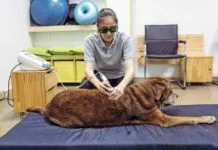When you think “hypothermia,” you likely think winter, however, a dog can get hypothermic even in summer if he is swimming and playing in cold water. Remember that wind and wet add to chill factors along with just temperature.
At first, with mild hypothermia, the symptoms or signs you will see are your dog shivering and lying down all curled up tight in an attempt to stay warm. At lower body temperatures, your dog’s body will start to shut down, slowing metabolism, and shifting blood flow to essential areas.
As the body temperature continues to drop, heart and respiratory rates increase briefly, trying to get things back to normal but then gradually slow down. Your dog’s gums may be pale with a slow capillary refill time. The dog will act depressed or logy and may lose consciousness in severe cases.
Technically, hypothermia is when your dog’s internal temperature drops to abnormally low, which is generally 98 to 99 degrees Fahrenheit or lower (normal canine body temperature is 101 to 102.5 degrees F).
How Long Does It Take to Get Hypothermia?
Neonatal puppies can develop fatal hypothermia quickly. Healthy adult dogs are more resistant to environmental factors due to body size, especially if the dog is heavily coated. Many of the livestock guarding breeds, if acclimated, are comfortable down to well below freezing temperatures, especially if they are dry and can get out of the wind.
My Cirneco dell’Etna dog, who weighs about 30 lbs and has a very short coat, loves to run and play in the snow. The minute he slows down, however, he starts to chill. He needs a coat, sometimes with fleece PJs underneath. My Belgian Tervurens, however, stay out much longer in cold weather and will happily lie down in snow and hang out.
How Long Does It Take A Dog To Recover From Hypothermia?
Recovery from a bout of hypothermia depends on many factors, including how low the body temperature became. A dry, cold dog can be warmed up faster and more easily than a wet, cold dog.
Warm the dog slowly. Bring your dog into a warm room and wrap him in a warm towel. Dry him off carefully. Do not do a lot of rubbing. If your dog has any degree of frostbite, rubbing can injure those susceptible tissues. That is especially true of tissues like ears and toes. Dogs with severe hypothermia may benefit from a veterinary visit to evaluate frostbite risk and for administration of warmed IV fluids.








